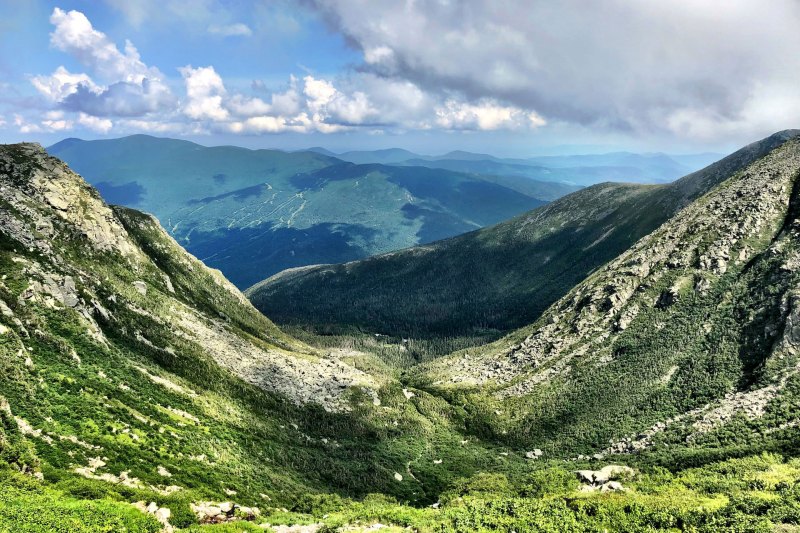Stretching for 2,193 miles from Georgia to Maine, the Appalachian Trail threads some of the East Coast’s wildest spaces — and each year, millions of people hike at least a portion of the trail (and approximately 1,000 people manage to hike the entire length).
During the fall, the epic footpath is a portal to some spectacular leaf-peeping spots. In fact, fall is one of the best times to hike the Appalachian Trail, as the lush green of the forest turns into a riot of autumn colors. Here are just a few of the best fall Appalachian Trail hikes for leaf peepers to enjoy the best foliage this autumn.
Mount Greylock, Massachusetts

Mount Greylock is among the highlights of Massachusetts’ 90-mile stretch of the Appalachian Trail. The highest point in the state, the 3,491 Mount Greylock has been enticing climbers for almost 200 years — and has even served as a muse for the likes of Herman Melville and Henry David Thoreau. It’s the centerpiece of the Mount Greylock Reservation, the oldest wilderness park in Massachusetts, created in 1898 to protect the mountain from regional logging operations. Today, the Appalachian Trail threads the whale-backed peak, with 11.5 miles of the footpath traversing the 12,500-acre Mount Greylock Reservation, and it is a great place to hike the Appalachian Trail in the fall.
For a fall hike with unsurpassed foliage views, make the 7.2-mile out-and-back trek to the summit from Jones Nose. The Jones Nose Trail meets the Appalachian Trail after just 1.2 miles, on the crest of Saddle Ball Mountain — the first 3,000-foot peak on the trail north of Virginia’s Shenandoah National Park. From Mount Greylock’s summit, views extend to four different states and include Vermont’s Green Mountains, the White Mountains of New Hampshire, and New York’s Catskills. For an overnight getaway, the historic Bascom Lodge is perched on the summit. Built by the Civilian Conservation Corps in the early 1930s, the stone-hewn lodge offers both shared bunkrooms and private rooms, with the season extending from May through October.
McAfee Knob, Virginia

Containing more mileage of the Appalachian Trail than any other state, Virginia’s 531-mile portion of the trail is loaded with spectacular spots — but McAfee Knob still stands out. The craggy promontory jutting dramatically from the flanks of Catawba Mountain rewards hikers with 270-degree views extending to the Roanoke Valley to the east, Tinker Cliffs to the north, and the Catawaba Valley and North Mountain to the west.
McAfee Knob, along with Dragon’s Tooth and Tinker Cliffs, has also been dubbed Virginia’s “Triple Crown” of hiking, a nickname bestowed on a stretch of the Appalachian Trail near Roanoke. However, for day-trippers, the shortest route to McAfee Knob is the 3.2-mile trek along the Appalachian Trail from the Catawba Valley, but the recently opened Catawba Greenway provides another option for reaching the top and cobbling together a 10-mile loop.
Mount Minsi, Pennsylvania

Anchored by a dramatic mile-wide rift in the Kittatiny Ridge carved by the Delaware River, the Delaware Water Gap National Recreation Area is stunning in the fall. The 70,000-acre recreation area spread along between New Jersey and Pennsylvania is blanketed with oak-dominated hardwood forests, providing plenty of seasonal flourish — and the park’s panoramic mountain ridges offer a bird’s-eye view of the river-threaded natural wonder.
For hikers, the Appalachian Trail dishes up some of the protected area’s most spectacular vistas. For a photogenic taste of the park’s 28-mile stretch of the Appalachian Trail, tackle the 5-mile out-and-back hike to the summit of Mount Minsi. The 1,461-foot peak provides expansive views of the Delaware Water Gap overseen by Mount Tammany, and along the way to the summit, hikers also skirt the shores of Lake Lenape, an idyllic spot to stop and photograph the fiery fall foliage.
Max Patch, North Carolina

A quintessential southern Appalachian bald, the treeless summit of Max Patch presides over North Carolina’s Cherokee National Forest. Once a grazing ground for sheep and cattle, the 4,629-foot summit is blanketed with expansive wildflower-sprinkled meadows and is still maintained by the U.S. Forest Service. And, from the peak’s grassy crown, hikers get an unsurpassed 360-degree view dominated by the Great Smoky Mountains to the south and the Black Mountains to the east, capped by Mount Mitchell, the highest summit east of the Mississippi River.
While there are shorter routes to the summit, the Appalachian Trail also threads the treeless peaks, offering a bounty of options for day hikers. To escape the crowds, climb Max Patch on the Appalachian Trail beginning at Lemon Gap. Along the 10.8-mile out-and-back trip to the summit, the Appalachian Trail weaves through creek-threaded hardwood forests tufted with rhododendrons. And, to make the trip an overnight excursion, the Roaring Fork Shelter is just 1.9 miles north of Max Patch’s summit on the Appalachian Trail.
Glastenbury Mountain, Vermont

In the early 1800s, Vermont’s Glastenbury Mountain was fodder for the regional mining and timber trade. But, after its forests were clear-cut and the mining industry began to fizzle, the wilderness gradually bounced back. These days, the Glastenbury Wilderness is the second largest in Vermont, a montage of hardwood forests of spruce, fir, birch, and mountain ash capped by 3,748-foot Glastenbury Mountain.
For hikers and backpackers, the Appalachian Trail cuts a path through the peak-rippled wilderness, sharing a path with Vermont’s 272-mile Long Trail, the oldest distance trail in the country. For a sampling of the 22,425-acre wilderness area, hike the Appalachian Trail to the crest of Little Pond Mountain. The 11-mile out-and-back includes generous Green Mountain views from the Little Pond Lookout and the peak’s crest. For a longer overnight outing, continue 4.6 miles on the Appalachian Trail to the summit of Glastenbury Mountain.
The refurbished fire tower perched atop the peak provides expansive views extending to the Berkshires in Massachusetts and New York’s Taconic range — and just below the summit, the Goddard Shelter provides a convenient spot for backpackers to spend the night.
Crawford Path, New Hampshire

Be warned, if you’re looking for an easy hike, this one is not for you. New Hampshire’s White Mountains are generally considered one of the hardest sections of the Appalachian Trail, with the most miles above treeline on the trail. The hike may be strenuous, but the spectacular views once you get above the treeline are well worth it.
You will also be hiking on a historic trail. Crawford Path, established in 1819, is the oldest continuously maintained
Be prepared

One of the keys to having a great fall hike on the Appalachian Trail is to be prepared for anything. Besides making sure you have a camera in your pack, you should also be prepared for unpredictable weather, especially in the Northeast, where a sunny day can turn into freezing rain in no time.
According to the Appalachian Trail Conservancy, it’s not uncommon to have snow on sections of the trail in New England in September or October. That’s why when you set out to hike the Appalachian Trail in fall for a foliage hike, you should have the proper gear for inclement weather, even if the sky looks clear.
Dressing in layers is the best way to stay ahead of the weather, so you can easily regulate your body temperature as you warm up during your hike. Make sure you have a long-sleeved shirt, a fleece-lined hat, gloves, and a raincoat in your pack, so you’re ready for whatever Mother Nature throws at you.
Now get out there and enjoy fall!




